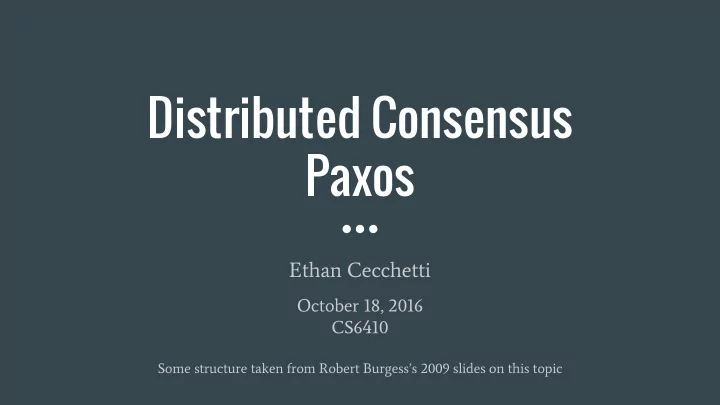

Distributed Consensus Paxos Ethan Cecchetti October 18, 2016 CS6410 Some structure taken from Robert Burgess’s 2009 slides on this topic
State Machine Replication (SMR) Server 1 Server 2 View a server as a state machine. S 0 S 0 S 0 To replicate the server: 1. Replicate the initial state a 2. Replicate each transition S 1 Client S 1 b S 2 S 2 2
Paxos: Fault-Tolerant SMR Devised by Leslie Lamport, originally in 1989 ● Written as “The Part-Time Parliament” ● Abstract: Recent archaeological discoveries on the island of Paxos reveal ○ that the parliament functioned despite the peripatetic propensity of its part-time legislators. The legislators maintained consistent copies of the parliamentary record, despite their frequent forays from the chamber and the forgetfulness of their messengers. The Paxon parliament’s protocol provides a new way of implementing the state-machine approach to the design of distributed systems. Rejected as unimportant and too confusing ● 3
Paxos: The Lost Manuscript Finally published in 1998 after it was put into use ● Published as a “lost manuscript” with notes from Keith Marzullo ● “This submission was recently discovered behind a filing cabinet in the TOCS editorial ○ office. Despite its age, the editor-in-chief felt that it was worth publishing. Because the author is currently doing field work in the Greek isles and cannot be reached, I was asked to prepare it for publication.” “Paxos Made Simple” simplified the explanation…a bit too much ● ○ Abstract: The Paxos algorithm, when presented in plain English, is very simple. 4
Paxos Made Moderately Complex Robbert van Renesse and Deniz Altinbuken (Cornell University) ACM Computing Surveys, 2015 “The Part-Time Parliament” was too confusing “Paxos Made Simple” was overly simplified Better to make it moderately complex! Much easier to understand 5
Paxos Structure Figure from James Mickens. ;login: logout. The Saddest Moment . May 2013 6
Paxos Structure Proposers Acceptors Learners 7
Moderate Complexity: Notation Function as proposers and Store data and propose learners without persistent storage to proposers Figure from van Renesse and Altinbuken 2015 8
Single-Decree Synod Proposer Acceptor i Decides on one command b = 0 b' = 0 System is divided into proposers and acceptors b = b + 1 The protocol executes in phases: Send (p1a,b) if (b' < b) b' = b 1a. Proposer proposes a ballot b Send (p1b,b',c i ) if (b' > b) 1b. Acceptor i responds with ( b' , c i ) b = b' abort 2a. If b' > b , update b and abort if majority c = b-max(c i ) Else wait for majority of acceptors Send (p2a,b,c) if (b' == b) Request received c i with highest ballot number accept (b',c) Send (p2b,b',c) 2b. If b' has not changed, accept A learner learns c if it receives the same (p2b, b',c) from a majority of acceptors 9
Optimizations: Distinguished Learner Proposers Acceptors Distinguished Learner Other Learners 10
Optimizations: Distinguished Proposer Other Proposers Distinguished Proposer Acceptors Learners 11
What can go wrong? A bunch of preemption ● If two proposers keep preempting each other, no decision will be made ○ Too many faults ● ○ Liveness requirements majority of acceptors ■ one proposer ■ one learner ■ ○ Correctness requires one learner 12
Deciding on Multiple Commands Run Synod protocol for multiple slots Slot 1 Sequential separate runs Synod c 1 Slow Slot 2 Parallel separate runs Multi-decree Synod c 2 Synod Broken (no ordering) Slot 3 Syond c 3 One run with multiple slots Multi-decree Synod! 13
Paxos with Multi-Decree Synod Like single-decree Synod with one key difference: ● Every proposal contains a both a ballot and slot number Each slot is decided independently ● On preemption ( if (b' > b) {b = b'; abort;} ), ● proposer aborts active proposals for all slots 14
Moderate Complexity: Leaders Leader functionality is split into pieces Scouts – perform proposal function for a ballot number ● ○ While a scout is outstanding, do nothing Commanders – perform commit requests ● If a majority of acceptors accept, the commander reports a decision ○ Both can be preempted by a higher ballot number ● ○ Causes all commanders and scouts to shut down and spawn a new scout 15
Moderate Complexity: Optimizations Distinguished Leader ● Provides both distinguished proposer and distinguished learner ○ Garbage Collection ● ○ Each acceptor has to store every previous decision Once f + 1 have all decisions up to slot s , no need to store s or earlier ○ 16
Paxos Questions? 17
CORFU: A Distributed Shared Log Mahesh Balakrishnan † , Dahlia Malkhi † , John Davis † , Vijayan Prabhakaran † , Michael Wei ‡ , and Ted Wobber † † Microsoft Research, ‡ University of California, San Diego TOCS 2013 Distributed log designed for high throughput and strong consistency. Breaks log across multiple servers ● “Write once” semantics ensure serializability of writes ● 18
CORFU: Conflicts What happens on concurrent writes? The first write wins and the rest must retry ● ○ Retrying repeatedly is very slow. Use sequencer to get write locations first ● 19
CORFU: Holes and fill What if a writer fails between getting a location and writing? Hole in the log! ● ○ Can block applications which require complete logs (e.g. SMR) Provide a fill command to fill holes with junk ● Anyone can call fill ○ If a writer was just slow, it will have to retry ○ 20
CORFU: Replication Shards can be replicated however we want ● Chain replication is good for low replication factors (2-5) ○ On failure, replacement server can take writes immediately ● ○ Copying over the old log can happen in the background. 21
Thank You! 22
Recommend
More recommend